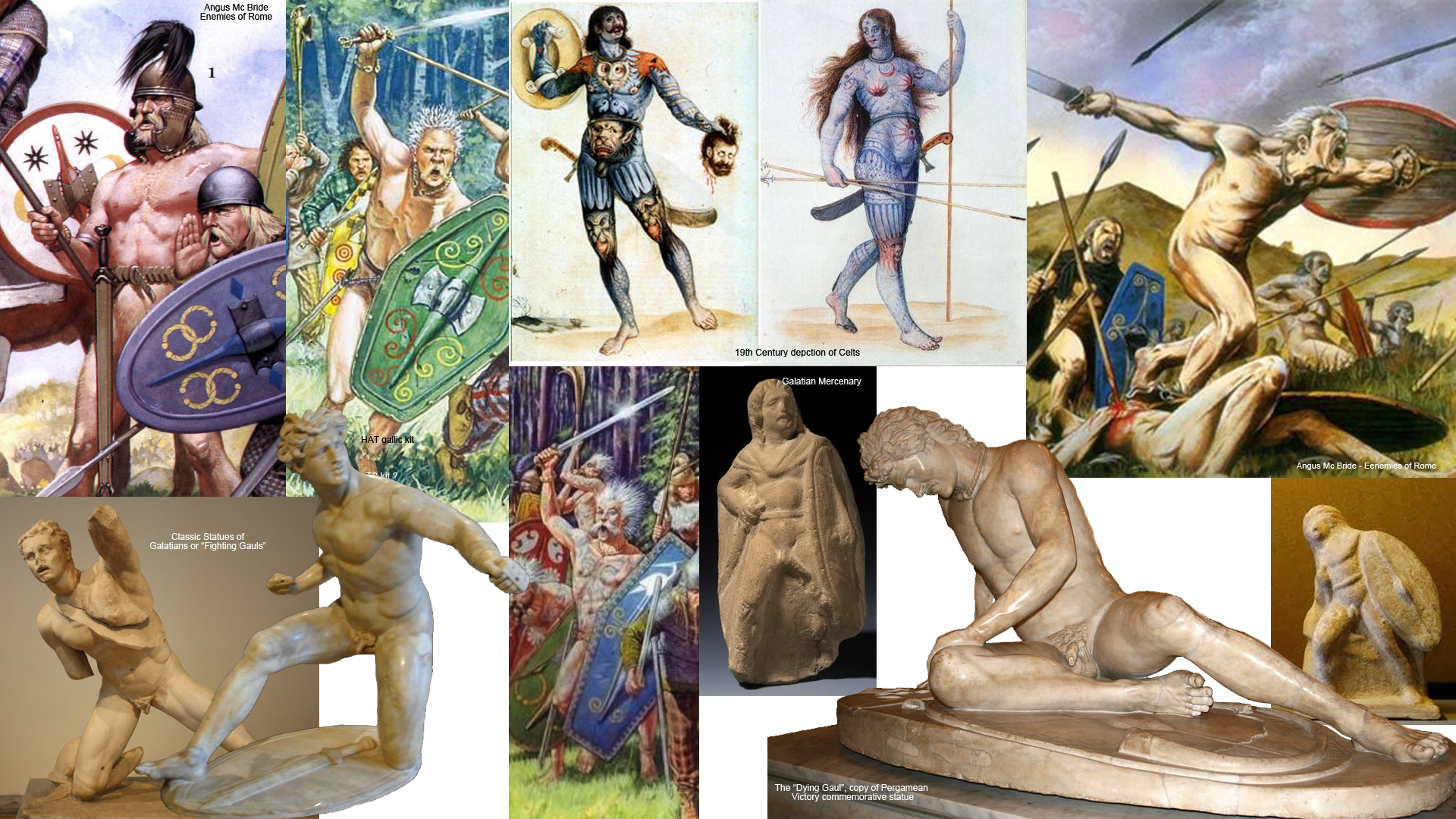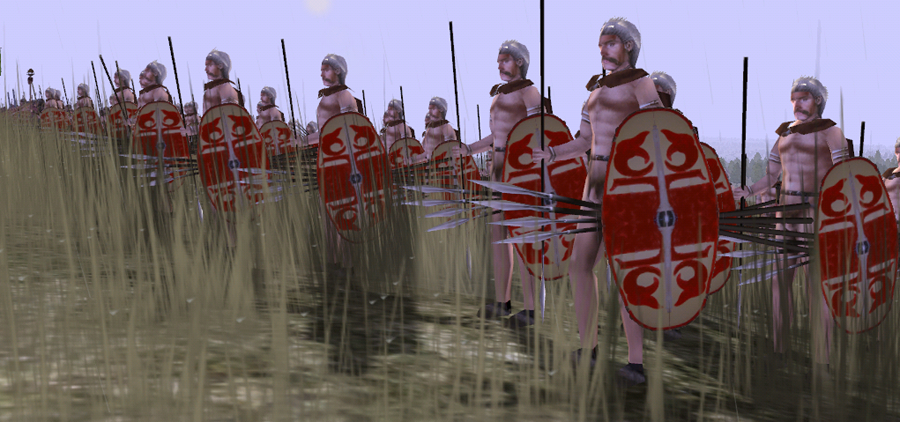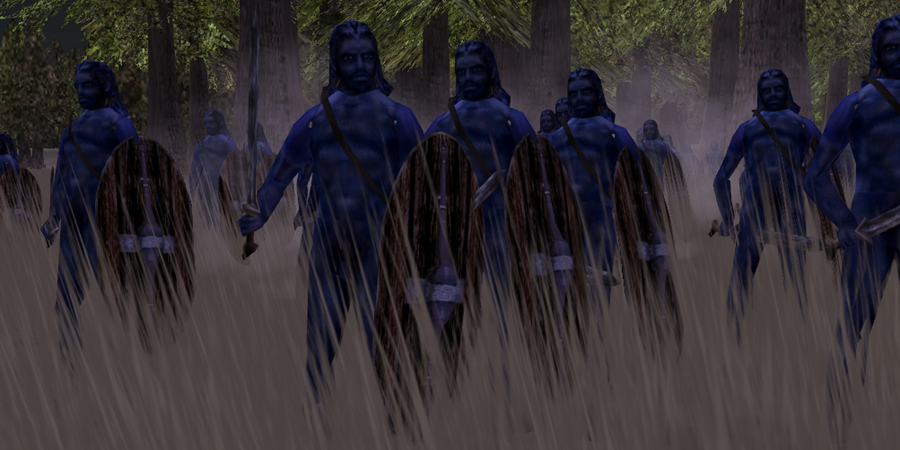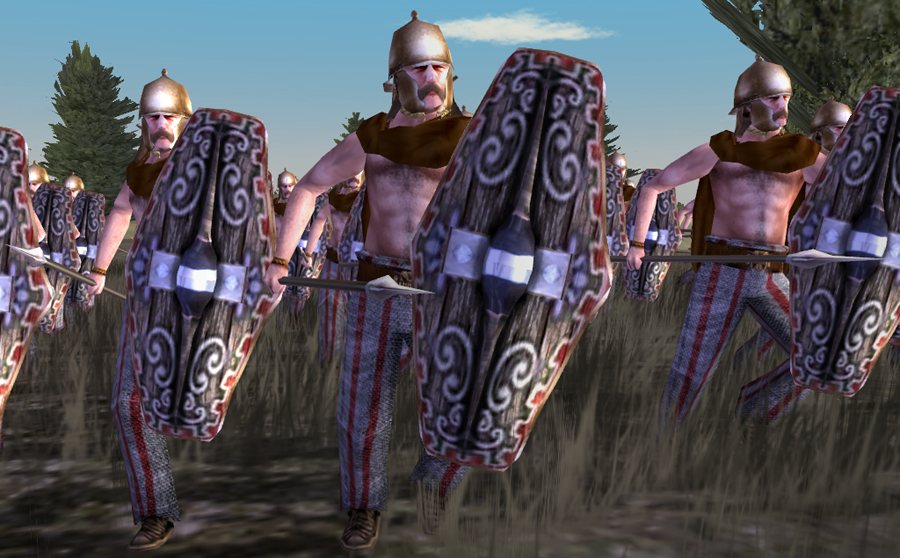
A mix of pictures gathered around the internet.
Γαισάται (Gaisatoi)
The Celtic Naked warriors of the antiquity When recalling enduring myths about the Keltoi - or Celts, the "naked warrior" is always part of the menu. How it's came about ? Ancient writers, both Greek and Roman, apparently have been impressed by these enough to report the fact several times. These were general depictions, with no names associated, until Polybius which, liking order, placed a sticker on the Gaesatae like many other units found in his "Histories". Naked warriors are apparently present in the works of some authors like Diodorus Siculus, which only mention "naked warriors" without a word or any precision. Also later on, as reported in some writings, pre-Christian Celtic warriors are mentioned as going into battle naked on a number of occasions, and most famously in the 5th Century AD the Picts which really scared the Romans. Those that invaded Italy in 390 BC fought naked. However there are doubt about the true sens of "naked". Fighting bare-chest, but still wearing trousers or even loincloth could have been also taken under the same umbrella. At least Polybius is more precise about that degree.
When recalling enduring myths about the Keltoi - or Celts, the "naked warrior" is always part of the menu. How it's came about ? Ancient writers, both Greek and Roman, apparently have been impressed by these enough to report the fact several times. These were general depictions, with no names associated, until Polybius which, liking order, placed a sticker on the Gaesatae like many other units found in his "Histories". Naked warriors are apparently present in the works of some authors like Diodorus Siculus, which only mention "naked warriors" without a word or any precision. Also later on, as reported in some writings, pre-Christian Celtic warriors are mentioned as going into battle naked on a number of occasions, and most famously in the 5th Century AD the Picts which really scared the Romans. Those that invaded Italy in 390 BC fought naked. However there are doubt about the true sens of "naked". Fighting bare-chest, but still wearing trousers or even loincloth could have been also taken under the same umbrella. At least Polybius is more precise about that degree.
Also later the consul Manlius Volso also reported to his men that the Galatian tribes still fought naked (2nd Century). As a proof, they are several statues (5-6) in existence today clearly showing naked celtic warriors: The most famous is probably the "dying gaul", a Galatian warrior wounded after the battle against Pergamum, part of the sculptures commissioned some time between 230 and 220 BC by Attalus I of Pergamon to celebrate his victory and later copied by the Romans. The sculpture is famous for several reasons. It proved the point of the "naked warriors" -although it could have just been an "exotic" subject for classical sculptor that woved a cult to human body) - compounded by the mentions of the Celts being muscular, and it showed clearly a gaul with his tork (which means probably a professional or wealthy warrior), and showed also clearly the pointy hairs that are also described.

Gauls and Celts in general were known in ancient times as "ferocious warriors". A pincer of salt must be taken with this. First off, the Roman themselves were no less "savage" in their behaviour, destroying entire cities, or villages, having all men killed, women raped and sold to slavery. Second, in particular for Caesar, it was more advantageous to portray the Gauls as "worthy opponents" for propaganda reasons. Towards the end of the 3rd century BC, a coalition of Insubres, Boii and the Taurisci attacked Rome from Northern Italy. Then Polybius insists in his depiction of the "Gaesatae" at Telamon being mercenaries. This is coherent with the name, but they are some confusions about their origin, which could have been both from the Rhone and Alps, payed by these "southerners", Gauls living in the Northern Italian fertile plains. The fact they fought naked and as a vanguard contrary to the Boii and Insubres, fully clothed and supposedly more professional, only seems to point out some sort of "expendable troops", poorly equipped and fanatic javelin fodder.
Polybius depiction analysis
Polybius depiction in "The Histories", Book II is about some Gaesatae (Latin) or Gaisatoi (Greek) fighting at the battle of Telamon in 225 BC. So using this specific event and Polybius description, the Gaesatae were a group of Gallic warriors living in the Alps near the river Rhodanus (Rhône). The depiction is relatively precise about the fact they undressed indeed, only carrying golden jewelry, but there is no mention of them carrying specific weapons nor a helmet or shield.22: "The two largest tribes, therefore, the Insubres and Boii, made a league and sent messengers to the Gauls dwelling among the Alps and near the Rhone, who are called Gaesatae because they serve for hire, this being the proper meaning of the word." -Note: So for Polybius "gaisatoi" (which would be a spear carrier) was synonymous for a mercenary among the Gauls.
23: "The Gaesatae, having collected a richly equipped and formidable force, crossed the Alps, and descended into the plain of the Po in the eighth year after the partition of Picenum."
27.3: "The Celts had drawn up facing their rear, from which they expected Aemilius to attack, the Gaesatae from the Alps and behind them the Insubres"
27.7: "The Insubres and Boii wore their trousers and light cloaks, 27.8 but the Gaesatae had discarded these garments owing to their proud confidence in themselves, and stood naked, with nothing but their arms, in front of the whole army, thinking that thus they would be more efficient, as some of the ground was overgrown with brambles which would catch in their clothes and impede the use of their weapons."
-Now this is interesting. Polybius' own interpretation of these warriors fighting naked was their confidence (into their gods?), he does not precise if they wore sacred tatoos; however for him the nature of the ground, bushes which would ampede their moves was another reason. We will discuss this more in detail below.
30.1 "But when the javelineers advanced, as is their usage, from the ranks of the Roman legions and began to hurl their javelins in well-aimed volleys, the Celts in the rear ranks indeed were well protected by their trousers and cloaks, 30.2 but it fell out far otherwise than they had expected with the naked men in front, and they found themselves in a very difficult and helpless predicament. 30.3 For the Gaulish shield does not cover the whole body; so that their nakedness was a disadvantage, and the bigger they were the better chance had the missiles of going home. 30.4 At length, unable to drive off the javelineers owing to the distance and the hail of javelins, and reduced to the utmost distress and perplexity, some of them, in their impotent rage, rushed wildly on the enemy and sacrificed their lives, while others, retreating step by step on the ranks of their comrades, threw them into disorder by their display of faint-heartedness. 30.5 Thus was the spirit of the Gaesatae broken down by the javelineers;"
-Note: That's too, is quite interesting. Not only for him their larger body size (compared to the Romans) made them easier targets (...), but "Gaulish shield does not cover the whole body". Indeed, classical gallic shield were about one meter high, flat and narrow. So were these ones specifically smaller ? If the Gaesatae were indeed javelineers, a lighter shield is required in general for more agility on the battlefield. However the description of them charging towards the enemy added to the fact they were mercenaries could indicate they fought also close and personal. There are, later indeed depiction of the Gallic swords "bending" easily, but that depiction does not concerns the Gaesatae who had retreated at this point. By keeping the strict definition of Gaesatae and not having other clues, we can assume these Gaesatae were indeed Alpine spear warriors, having only melee spears as there is nothing about the use of throwing spears in this engagement, only on the Roman side.
Also the lack of skills supposed to not be capable of dodging the Roman javelins could suggest somewhat inexperienced warriors. Added to the fact these were armed only by spears, a far cheaper weapon that a sword, could indicate they were poorers, which is logical in the mountaineer, alpine context of poor remote villages. Mountaineers were in general more "savage" and reckless to compensate their lack of equipment. Also in this context, being hired as mercenaries is still logical. So the definitive portrayal we could have of these Gaesatae were 1-Polybius assimilating an unidentified people (a Rhône valley tribe) with their role as spearman mercenaries from this region. 2-Relatively weak infantry fighting with spears, perhaps naked for religious reasons, more likely than to be supposedly more agile on the battlefield or pure confidence.

Night fighters like the "Runocingetos" or the German "Harii" were also known to fight naked, with darj body paint, either dark blue or black (catw).
General conclusion
Historically, the Gaesatae seems to have been Gallic naked low-extraction mercenaries. To compensate perhaps, their size and skills, terrifying cries and tauntings, were compounded by their seeming invincibility. So their appearance in this context should be seen as a psychological weapon. Gauls and Celts in general were known to use a frenetic charge after much "preparation", the famous tumultus gallicus among others. Enemy lines were supposed to break after the initial shock. That is usual foes BUT the Romans, unfortunately as hitory showed.Were they comparable in some ways to German Berserkirs, possibly some, in another context, having ingested or applied chemical potions supposed to delete pain and fatigue, were also capable of ripping javelins that had struck them, free from their bodies to hurl them back ?.
All in all, the Gaesatae do not seem to have been a tribe in themselves and appeared out from the blue, without any previous depiction or origin story and only mentioned once, in 231 BC. Confusingly, Polybius saying that they were a tribe that living on the Rhone as well as from the Alps are not convincing to say the least. For him they are just 'serving for hire'. Two possible origins for this name came to mind, *gaiso- proto-Celtic word meaning 'spear' in the context of being mercenary; Second from 'gaesat' in Germanic language woukd came from 'ge-', a prefix used to intensify an action by a collective group, 'sat', meaning to settle somewhere, for a possible 'settlers' perhaps of Germanic origin in this region, just like the Boii, which meaning is comparable.
 There are doubt about the term "naked" for ancient authors. Apart Polybius description which is precise, some could have been just bare-chested, which was enough to have been remarked (catw).
There are doubt about the term "naked" for ancient authors. Apart Polybius description which is precise, some could have been just bare-chested, which was enough to have been remarked (catw).
Still, however, according to Polybius, a number of them may could have been related to the Senones which sacked Rome in 389 BC and settled in Northern Italy since - still the idea of "settlers". They had two elected "kings", (or chieftains, more likely) which could have made them the prominent group within the mercenary body, the rest being Celtic tribes of the Alps and the Rhone and more likely outside any Germanic influence in that area. On 34.2 "...On meeting with a refusal, the Celts decided to resort to their last hope and again appealed to the Gaesatae on the Rhone, and hired a force of about thirty thousand men. When they had these troops they kept them in readiness and awaited the attack of the enemy.": We can translate this as "mercenaries from the Rhone".
From Plutarch more modern authors attribute to the word "Gaisatoi", "Gessatai", al. Gcsatai, Gessati, whom they seem to believe transalpine, the sense of men who fight as mercenaries, meaning that accords with one of those which Hesychius attaches to the word Gaisos; the others are those of non all-iron weaponry. Again, after Polybius these Gaesatae showed apparent vanity and bravado by throwing off their clothing. Were baggy Celtic trousers still could impede the use of their weapons ? Only reenacters acting in the same area of Telamon could put the light of what could be Polybius misinterpretation of a possible psychological tactic or religious fervor. They could act like this as to unnerve or disrespect the enemy as well as show contempt for the foe and fearlessness in their own ranks. What is certain, is Halstatt warriors (800-500 BCE) apparently had no trousers, or narrow clothes around their legs (or boots). And they were mountaineers because of the area, Swiss and Austria, Northern Alps. So they would have some clues about fighting without "baggy trousers", same as related Ligurians, also living in relatively mountainous areas along the coast. Again only reenactment, and the still possible find of a statue could give some clue about this myth about the "naked celt".
Sources
https://en.wikipedia.org/wiki/Gaesataehttp://www.historyfiles.co.uk/KingListsEurope/BarbarianGaesatae.htm
Google Books Ethnologie Gauloise ou Memoires Critiques D.F. Belloguet
Entremont et l'impérium arverne ptie. De Segovese à Hannibal
https://www.mundusbellicus.fr/forum/espace-communautaire/l-agora/histoire/antiquit%C3%A9/503-celtes-vocabulaire-militaire
♕ Aquitani & Vasci ♕ Celts ♕ Indo-greeks ♕ Veneti ♕ Yuezhi ♕ Indians ♕ Etruscans ♕ Numidians ♕ Samnites ♕ Judaean ♕ Ancient Chinese ♕ Corsico-Sardinians
⚔ Cingetos ⚔ Immortals ⚔ Cavaros ⚔ Cataphract ⚔ Romphaiorioi ⚔ Chalkaspidai ⚔ Devotio Warrior ⚔ Scythian Horse archer ⚔ The Ambactos ⚔ Iberian warfare ⚔ Illyrian warriors ⚔ Germanic spearmen ⚔ Carthaginian Hoplite ⚔ Thracian Peltast ⚔ Caetrati ⚔ Ensiferi ⚔ Hippakontistai ⚔ Hastati ⚔ Gaesatae ⚔ Cretan Archer ⚔ Thorakitai ⚔ Soldurii ⚔ Iphikrates ⚔ Kardaka ⚔ The thureophoroi